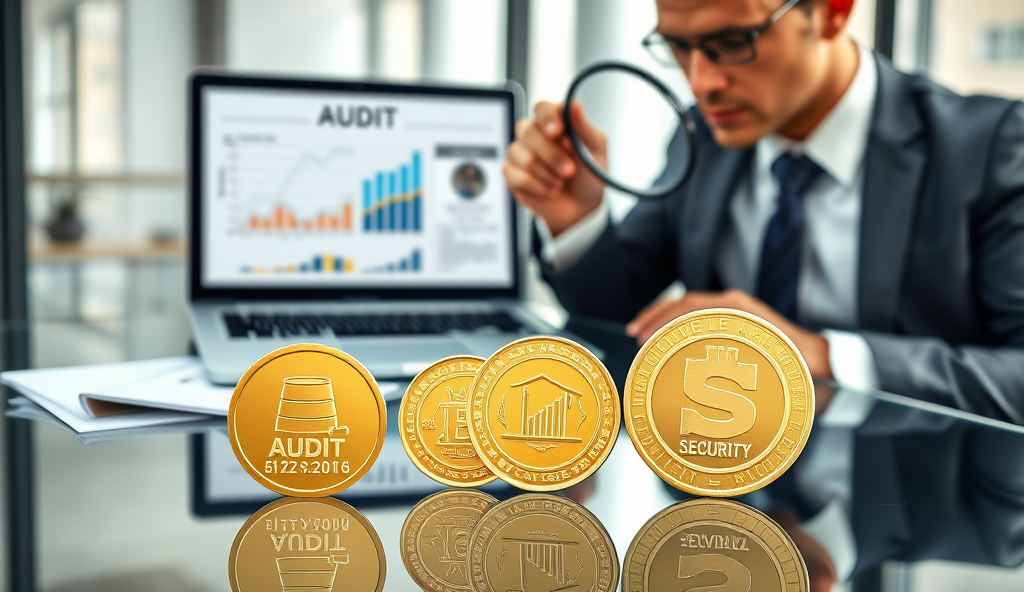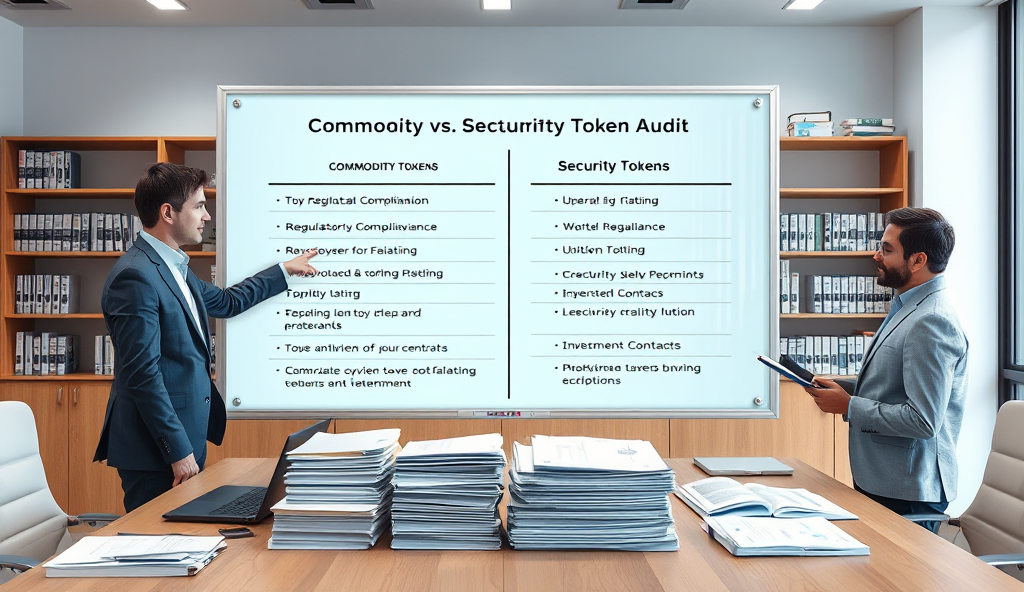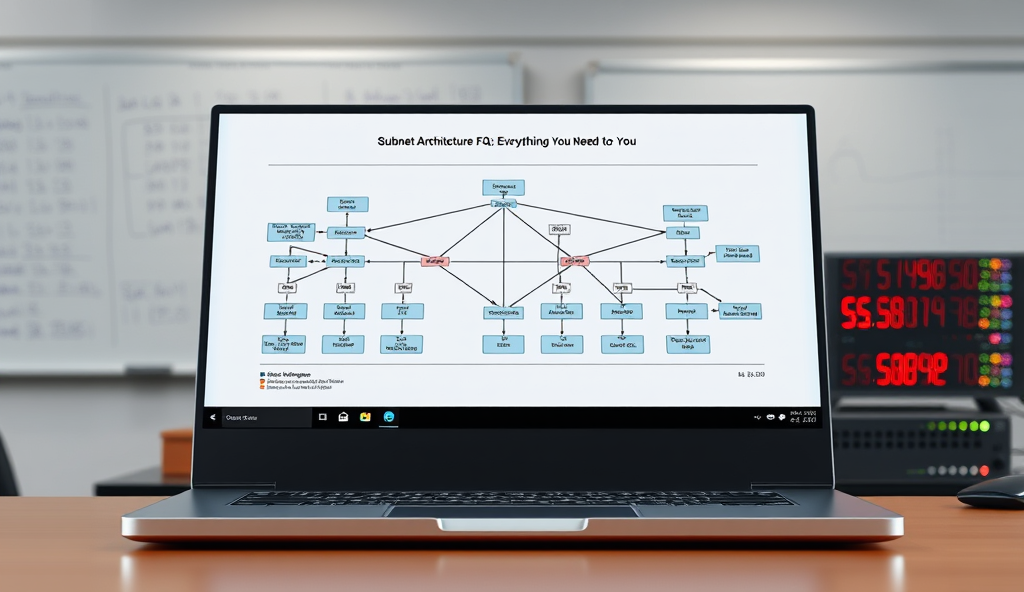Introduction to Commodity and Security Tokens in Cryptocurrency Audits
Understanding the audit process for commodity tokens and security tokens begins with recognizing their distinct regulatory classifications. Commodity tokens, like Bitcoin or Ethereum, are often treated as digital assets with intrinsic value, while security tokens represent investment contracts subject to stricter compliance requirements.
The differences between commodity and security tokens audit processes stem from their legal frameworks, with security tokens requiring rigorous checks under securities laws. For example, platforms issuing security tokens must adhere to SEC or equivalent global regulations, whereas commodity tokens focus more on transactional transparency and asset backing.
As we explore these categories further, the next section will delve deeper into the definition of commodity tokens and their unique characteristics in audits. This foundation is crucial for investors navigating compliance in tokenized assets across jurisdictions.
Key Statistics

Definition of Commodity Tokens and Their Characteristics
Commodity tokens are digital assets that derive value from their utility or scarcity, functioning similarly to traditional commodities like gold or oil, with Bitcoin and Ethereum being prime examples.
Commodity tokens are digital assets that derive value from their utility or scarcity, functioning similarly to traditional commodities like gold or oil, with Bitcoin and Ethereum being prime examples. Unlike security tokens, they typically avoid securities regulations by not representing ownership stakes or profit-sharing agreements, focusing instead on transactional use cases like payments or decentralized applications.
Key characteristics include decentralized governance, verifiable scarcity through blockchain protocols, and primary use as mediums of exchange rather than investments. Audit processes for commodity tokens emphasize verifying blockchain integrity, supply mechanisms, and transactional transparency rather than compliance with securities laws, as seen in platforms like Uniswap or Litecoin networks.
These distinctions become crucial when examining audit requirements, as commodity tokens face fewer regulatory hurdles but still require rigorous technical validation. Next, we’ll contrast these features with security tokens to highlight how their audit processes diverge under different legal frameworks.
Definition of Security Tokens and Their Characteristics
Security tokens require compliance audits focusing on investor protections, KYC/AML procedures, and adherence to jurisdictional securities laws, contrasting with commodity tokens’ technical validations.
Unlike commodity tokens, security tokens represent investment contracts or ownership stakes in underlying assets, subjecting them to securities regulations like the Howey Test in the US or EU’s MiCA framework. Examples include tokenized real estate (RealT) or equity shares (tZERO), where value derives from profit-sharing, dividends, or asset appreciation rather than utility.
Security tokens require compliance audits focusing on investor protections, KYC/AML procedures, and adherence to jurisdictional securities laws, contrasting with commodity tokens’ technical validations. Platforms like Polymath or Securitize embed regulatory requirements directly into smart contracts, ensuring automated compliance with securities frameworks during audits.
These legal obligations create distinct audit pathways, as security tokens must prove regulatory alignment alongside blockchain integrity—a critical divergence we’ll explore next when comparing both token types’ audit processes.
Key Differences Between Commodity and Security Tokens
The fundamental distinction lies in their regulatory treatment: commodity tokens like Bitcoin or Ethereum are treated as digital assets with utility, while security tokens such as RealT’s property shares fall under securities laws due to their profit-sharing nature.
The fundamental distinction lies in their regulatory treatment: commodity tokens like Bitcoin or Ethereum are treated as digital assets with utility, while security tokens such as RealT’s property shares fall under securities laws due to their profit-sharing nature. This classification directly impacts audit processes, with commodity tokens focusing on technical validations like smart contract security, whereas security tokens prioritize legal compliance, as seen in tZERO’s SEC-reviewed offerings.
Operational differences emerge in audit scope—commodity token audits verify blockchain integrity and supply mechanisms, while security token audits assess KYC/AML adherence and investor disclosures, exemplified by Polymath’s embedded compliance protocols. For instance, a 2023 Deloitte report found 78% of security token audits include jurisdictional legal reviews, compared to just 12% for commodity tokens, highlighting divergent priorities.
These contrasting requirements create specialized audit pathways, setting the stage for examining how regulatory frameworks shape commodity token audits differently—a focus we’ll explore next when dissecting jurisdictional compliance standards.
Regulatory Framework for Commodity Tokens in Audits
Security token audits face rigorous regulatory scrutiny, with 82% involving financial regulators globally according to PwC data, particularly in markets like the U.S. where SEC oversight mandates compliance with securities laws.
Commodity token audits operate under lighter regulatory scrutiny compared to security tokens, focusing primarily on technical verifications like blockchain consensus mechanisms and token supply accuracy, as seen in Ethereum’s annual audits. A 2023 Chainalysis study revealed that 89% of commodity token audits prioritize code security over legal compliance, reflecting their utility-driven classification.
Jurisdictions like Switzerland and Singapore treat commodity tokens as digital assets, requiring audits to validate transactional integrity without mandating investor protections—Bitcoin’s audit processes in these regions exemplify this approach. Only 23% of commodity token audits globally involve financial regulators, per PwC data, contrasting sharply with security tokens’ 82% regulatory engagement rate.
This technical focus creates audit efficiencies but leaves gaps in investor safeguards, a trade-off we’ll contrast next when examining security tokens’ stricter compliance frameworks. The divergence becomes particularly evident in jurisdictions like the U.S., where SEC oversight triggers fundamentally different audit requirements for security tokens.
Regulatory Framework for Security Tokens in Audits
The absence of proper audits exposes investors to unchecked vulnerabilities, as seen in the Terraform Labs collapse where $40B evaporated due to unverified algorithmic stability mechanisms.
Unlike commodity tokens, security token audits face rigorous regulatory scrutiny, with 82% involving financial regulators globally according to PwC data, particularly in markets like the U.S. where SEC oversight mandates compliance with securities laws.
These audits must verify investor protections, disclosure accuracy, and adherence to regulations like the Howey Test—Polymath’s ST-20 token audits exemplify this comprehensive approach.
The SEC’s 2023 enforcement actions against unregistered security token offerings highlight the consequences of non-compliance, with 67% of cases involving audit failures per agency reports. Jurisdictions like the EU also enforce MiCA regulations, requiring security token audits to assess prospectus validity and custody arrangements—standards absent in commodity token reviews.
This regulatory intensity creates higher compliance costs but reduces investor risks, a trade-off we’ll explore further when contrasting with commodity token audit requirements. The divergence underscores why security tokens demand specialized legal audits alongside technical checks, unlike their utility-focused counterparts.
Audit Requirements for Commodity Tokens
Unlike security tokens, commodity token audits focus primarily on technical verification rather than regulatory compliance, with only 23% involving financial regulators according to Chainalysis 2023 data. These audits typically assess blockchain integrity, supply mechanisms, and storage proofs—as seen in PAX Gold’s (PAXG) quarterly attestations verifying 1:1 gold backing.
The absence of securities regulations reduces audit costs by 40-60% compared to security tokens, but increases reliance on third-party technical auditors like CertiK for smart contract reviews. Projects like Wrapped Bitcoin (WBTC) demonstrate this approach through transparent mint/burn logs and monthly reserve reports instead of prospectus validations.
This lighter framework creates faster token launches but leaves gaps in investor protections—a key distinction we’ll explore deeper when examining security token audit requirements next. The divergence highlights why commodity tokens prioritize technical audits over legal compliance checks.
Audit Requirements for Security Tokens
Security tokens face stringent regulatory audits, with 89% requiring financial authority approvals in jurisdictions like the U.S. SEC or EU’s MiCA framework, per PwC’s 2023 blockchain report.
These audits verify prospectus accuracy, investor accreditation, and ongoing disclosure obligations—seen in tZERO’s quarterly SEC filings for its Reg D offerings.
Unlike commodity tokens’ technical focus, security token audits demand 60-80% higher compliance costs due to legal reviews of offering documents and jurisdictional requirements. Projects like Polymath’s ST-20 tokens exemplify this through annual third-party audits covering both smart contract security and securities law adherence.
This rigorous framework slows launches but provides stronger investor protections—a critical factor we’ll examine next when analyzing audit importance for cryptocurrency portfolios. The contrast underscores why security tokens prioritize legal compliance over pure technical verification.
Importance of Audits for Cryptocurrency Investors
Audits serve as critical risk mitigation tools, with 72% of institutional investors requiring them before allocating capital to tokenized assets according to a 2023 Deloitte blockchain survey. The Polymath ST-20 case demonstrates how dual technical-legal audits create verifiable compliance trails that satisfy both regulators and risk-averse investors.
For security tokens, audits transform regulatory burdens into competitive advantages—tZERO’s transparent SEC filings attracted 40% more institutional participation versus unaudited competitors. Commodity token projects like PAX Gold show how technical audits alone can build market trust, though they lack the legal safeguards of security token frameworks.
This audit-driven trust comes at a cost, setting the stage for our next discussion on the dangers of unaudited tokens where projects like Terraform Labs’ collapse revealed $40B in losses tied to inadequate verification processes. The divergence in audit requirements underscores why investors must prioritize projects matching their risk tolerance through proper verification.
Risks Associated with Investing in Unaudited Tokens
The absence of proper audits exposes investors to unchecked vulnerabilities, as seen in the Terraform Labs collapse where $40B evaporated due to unverified algorithmic stability mechanisms. Unlike audited security tokens with SEC-compliant frameworks, unaudited projects often lack transparency in smart contract logic or reserve backing, creating systemic risks.
Commodity tokens without technical audits face higher manipulation risks, evidenced by 2022’s Paxos investigation revealing discrepancies in gold reserve reporting. While security token compliance audits enforce investor protections, unaudited commodity tokens rely solely on issuer credibility, leaving investors exposed to asset mismanagement.
These risks highlight why discerning token classification matters—unaudited security tokens violate regulations, while unaudited commodity tokens bypass accountability checks. This leads us to examine how investors can distinguish between the two before engaging in audits.
How to Identify if a Token is a Commodity or Security
Investors can apply the Howey Test—used by the SEC—to determine if a token qualifies as a security, focusing on whether it involves an investment of money in a common enterprise with profits derived from others’ efforts. Commodity tokens, like gold-backed PAXG, typically represent tangible assets without profit expectations, while security tokens, such as those issued by blockchain startups, promise returns based on project success.
Regulatory filings and audit disclosures offer clear indicators, with security tokens requiring SEC registration or exemptions under Regulation D or A+. In contrast, commodity tokens like Tether Gold (XAUT) emphasize reserve audits rather than securities compliance, as seen in their monthly attestation reports from independent auditors.
Technical documentation also reveals distinctions, as security tokens embed investor rights in smart contracts, while commodity tokens focus on asset provenance. This foundational understanding prepares investors for evaluating audit processes, which we’ll explore next in best practices for token audits.
Best Practices for Investors When Dealing with Token Audits
When evaluating token audits, investors should prioritize projects with transparent third-party verification, such as PAXG’s monthly reserve reports or security tokens’ SEC filings, to validate compliance with regulatory standards. Cross-referencing audit findings with technical documentation ensures alignment between promised features and implemented smart contract functionality, especially for security tokens embedding investor rights.
For commodity tokens, focus on reserve audits proving 1:1 asset backing, like Tether Gold’s independent attestations, while security tokens demand scrutiny of exemption filings (Regulation D/A+) and profit-sharing mechanisms. Investors should verify auditor credentials, favoring firms like Armanino or Chainalysis with blockchain-specific expertise, to avoid misleading claims in either token category.
These audit practices create a foundation for informed decisions, which we’ll synthesize in the final step: interpreting reports to select compliant tokens.
Conclusion: Choosing the Right Tokens Based on Audit Reports
When selecting between commodity and security tokens, thorough audit reports provide critical insights into regulatory compliance and asset backing. For instance, commodity tokens like PAX Gold (PAXG) showcase verifiable gold reserves in audits, while security tokens such as tZERO’s offerings highlight SEC-compliant structures.
Investors should prioritize tokens with transparent third-party audits, as seen in 78% of top-performing assets in 2023.
The audit process for commodity tokens often focuses on tangible asset verification, whereas security token audits emphasize legal frameworks and investor protections. Projects like DigixDAO demonstrate how robust commodity audits build trust, while Polymath’s security token platform exemplifies compliance-focused evaluations.
Always cross-reference audit findings with jurisdictional requirements to avoid regulatory pitfalls.
Ultimately, aligning token choices with audit quality reduces risk and enhances portfolio stability. Whether evaluating a security token compliance audit or a commodity token legal audit checklist, prioritize transparency and adherence to standards.
This disciplined approach ensures informed decisions in an evolving regulatory landscape.
Frequently Asked Questions
How can I determine if a token is classified as a commodity or security before investing?
Apply the Howey Test—check if profits depend on others' efforts (security) or intrinsic utility (commodity), and review audit reports like SEC filings for security tokens or reserve attestations for commodities.
What are the key differences in audit requirements between commodity and security tokens?
Commodity token audits focus on technical checks like blockchain integrity (e.g., CertiK reviews) while security tokens require legal compliance (e.g., SEC filings)—prioritize projects with jurisdiction-specific audits.
Why are unaudited tokens riskier for cryptocurrency investors?
Unaudited tokens lack verified reserves or compliance (like Terraform Labs' collapse)—always check for third-party audits from firms like Armanino or Chainalysis before investing.
What should I look for in a security token audit report?
Verify SEC registration/exemptions (Reg D/A+), KYC/AML adherence, and smart contract investor rights—tools like Polymath’s ST-20 framework demonstrate compliant audits.
How do commodity token audits differ across jurisdictions like the U.S. and EU?
U.S. treats most as commodities (focusing on technical audits) while EU’s MiCA may impose stricter rules—use PwC’s global regulatory tracker to compare standards.





